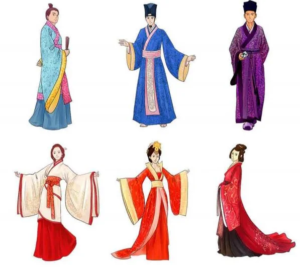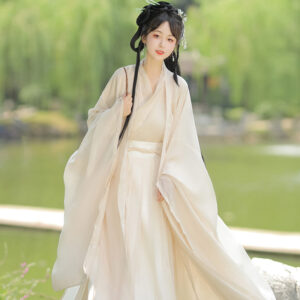
Hanfu, or “汉服,” refers to the traditional clothing worn by the Han ethnic group in China. The Han Dynasty (206 BCE – 220 CE) marked a significant period for Hanfu, characterized by distinct features that reflect the cultural values and aesthetics of ancient Chinese society. Key elements include cross-collared robes, wide sleeves, and a belt to cinch the waist. These garments not only served practical purposes but also conveyed deep cultural meanings and social status within the community.The Han Dynasty’s Hanfu is a rich tapestry of cultural significance, artistry, and historical context. This clothing style is not merely functional; it embodies the philosophical and social ideals of the time. The garments were designed with careful consideration of both aesthetics and practicality, reflecting the values of harmony, balance, and unity that were central to Confucian philosophy. Each element of Hanfu was thoughtfully crafted to represent not just individual identity but also the collective values of society.

Design and Structure of Han Dynasty Hanfu
The design of Hanfu during the Han Dynasty is notable for its simplicity and profound symbolism. The garments were structured to reflect the values of harmony and unity prevalent in Chinese philosophy.Cross-collar robes are perhaps the most iconic feature of Hanfu. This design element involves having the right side of the garment overlap the left, which symbolizes balance and harmony—essential tenets in Confucian thought. This cross-collar style is not just a fashion statement; it represents a deeper philosophical understanding of duality and balance in life.Wide sleeves are another defining characteristic of Hanfu. These flowing sleeves not only add an element of elegance but also allow for freedom of movement, making them practical for daily activities. The wide sleeves can be seen as an invitation to embrace life fully, allowing for gestures that express emotion and connection with others.A belted waist provides structure to the flowing garments while also emphasizing the wearer’s form. The belt serves both a practical purpose—keeping the robe secure—and a symbolic one, representing self-discipline and control over one’s desires. This duality reflects broader societal values that prioritize moderation and balance.
Materials and Fabrication Techniques
The choice of materials used in Hanfu reflects both luxury and practicality. Silk was the predominant fabric during this period, known for its luxurious texture and sheen. It was associated with wealth and status, making it a preferred choice among nobility. The production of silk was highly developed during the Han Dynasty, leading to an abundance of fine silk fabrics that could be dyed in vibrant colors.Cotton and linen were also utilized for their comfort and breathability, especially in warmer climates. These materials allowed for more casual styles that were accessible to commoners, demonstrating how clothing could signify both status and practicality.Innovative weaving techniques emerged during this time, allowing for intricate designs and patterns that enhanced the aesthetic appeal of garments. The artistry involved in fabric production was highly regarded, with skilled artisans creating textiles that featured elaborate motifs symbolizing various aspects of life, such as nature, mythology, and social status.
Symbolic Decorations and Patterns
The embellishments on Hanfu serve as a window into the rich cultural heritage of the Han Dynasty. Common motifs included dragons, phoenixes, and floral patterns that symbolized power, nobility, good fortune, and longevity. Each design element carried specific meanings that resonated with cultural beliefs.Embroideries were particularly significant in conveying social status and personal identity. The intricate needlework required skill and artistry, making embroidered garments highly sought after among those who could afford them. This artistry not only beautified clothing but also served as a means of storytelling through visual symbols.Color significance played a crucial role in determining social hierarchy within Hanfu styles. Colors were carefully chosen to represent various meanings; for example, yellow was reserved for emperors as it symbolized supreme authority. Other colors had their own connotations—red symbolized good luck while blue represented tranquility—making color choices an essential aspect of garment design.
Representation of Social Hierarchy
Hanfu was not just clothing; it was a visual representation of social status within ancient Chinese society. Distinct styles varied significantly based on one’s social rank. High-ranking officials wore elaborate robes adorned with intricate patterns that conveyed their elevated status within the imperial hierarchy.Distinct styles for different classes served as a reminder of societal roles. Commoners donned simpler designs that reflected their status while adhering to ethical codes emphasizing modesty and humility. This clear delineation between styles ensured that clothing acted as a visual cue for social interaction.Ethical codes dictated appropriate attire based on context—formal occasions required more elaborate garments while everyday wear could be simpler yet still respectful. This adherence to societal norms reinforced Confucian ideals regarding propriety and respect within interpersonal relationships.
Cultural Significance
Hanfu played a pivotal role in traditional ceremonies and rituals throughout the Han Dynasty. Specific styles were worn during significant life events such as weddings or ancestral worship ceremonies. These garments were chosen to signify purity and respect toward family traditions.Cultural continuity is another important aspect associated with Hanfu. Despite evolving fashion trends over millennia, Hanfu remains a symbol of cultural heritage that connects modern Chinese people with their ancestors. Its revival in contemporary society highlights an ongoing appreciation for traditional values amidst rapid modernization.The use of Hanfu in ceremonial contexts underscores its significance beyond mere clothing; it acts as a bridge between past traditions and present identities. Wearing Hanfu today allows individuals to express their cultural pride while participating in rituals that honor history.
Regional Variations
The vast geography of China during the Han Dynasty led to distinct regional variations in Hanfu styles. Climate played a significant role in determining fabric choices; colder regions favored heavier fabrics for warmth while lighter materials were preferred in warmer areas for comfort.Local motifs influenced patterns incorporated into garments, reflecting local identities shaped by geography and culture. For instance, certain regions may have favored floral designs inspired by local flora or specific color palettes associated with regional customs.These regional variations contributed to a rich diversity within Hanfu styles while maintaining core elements characteristic of the broader tradition. Such diversity illustrates how clothing can adapt to environmental conditions while still conveying shared cultural values.
Innovations in Textile and Design
The innovations during this period set standards that would influence Chinese clothing for centuries to come. Advanced textile production techniques allowed artisans to create finer yarns enabling more intricate designs than ever before.Embroidery became a sophisticated art form during this time; detailed motifs reflected auspicious symbols believed to bring good fortune or ward off evil spirits. This artistic expression elevated clothing beyond mere utility into realms of beauty and spirituality.These innovations not only enhanced aesthetic appeal but also contributed to economic growth through increased textile production capabilities. The demand for high-quality fabrics fueled trade networks both domestically and internationally, further embedding Hanfu into broader cultural exchanges.
Table: Key Features of Han Dynasty Hanfu
| Feature | Description |
|---|---|
| Cross-Collar Robes | Symbolizes harmony; right side overlaps left representing balance in life. |
| Wide Sleeves | Adds elegance; allows freedom of movement essential for daily activities. |
| Belted Waist | Provides structure; emphasizes form while reflecting self-discipline values. |
| Materials | Primarily silk; also cotton & linen used based on comfort & availability. |
| Embroideries | Common motifs include dragons & phoenixes; symbolize power & fortune. |
| Color Significance | Colors denote social status; yellow reserved for emperors indicating authority. |
| Social Hierarchy | Distinct styles based on rank; ethical codes dictate modesty & propriety. |
| Ceremonial Importance | Specific styles worn during significant life events like weddings & rituals. |
| Regional Variations | Influenced by geography; heavier fabrics in cold regions vs lighter ones in warm areas. |
Conclusion
The features of Han Dynasty Hanfu encapsulate not only an era’s fashion but also its philosophical ideals and cultural values. Each element—from design to material—serves as a testament to the rich heritage of Chinese civilization, making it an enduring symbol of identity for generations to come.For further exploration into this topic, you can refer to authentic sources such as Wikipedia or specialized articles on traditional Chinese clothing.
Share this post
Recent Posts


What were the key features of Hanfu during the Tang Dynasty?

How did Hanfu styles vary during different Chinese dynasties?

What accessories are typically worn with Hanfu?

How do you choose the right Hanfu for different seasons?

Newsletter
Popular Categories
Related Post
Sed aliquam, tortor et sodales malesuada, lorem leo luctus tellus, quis interdum eros nibh in nunc. Cras dignissim malesuada, lorem leo luctus

What are the winter hanfu called?

What were the key features of Hanfu during the Tang Dynasty?

How did Hanfu styles vary during different Chinese dynasties?


